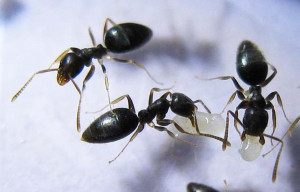Many households in Tasman are currently facing ant infestations, likely due to a very successful breeding season. Effective ant control depends on correctly identifying the species, as different types require different treatment methods.
The two most common ant invaders of homes in Tasman are white-footed house ants and Argentine ants.
White footed house ants
 White-footed house ants, originally from Indonesia, measure between 2.5 and 3.0 mm in length. They are black with distinctive white feet - though you’d need a magnifying glass to spot that detail. In comparison, Argentine ants are slightly smaller, ranging from 2.0 to 3.0 mm long, and are characterized by their honey-brown colouration. If you place your hand over a trail of ants, Argentine ants will continue crawling over it without hesitation, while white-footed house ants will scatter and flee.
White-footed house ants, originally from Indonesia, measure between 2.5 and 3.0 mm in length. They are black with distinctive white feet - though you’d need a magnifying glass to spot that detail. In comparison, Argentine ants are slightly smaller, ranging from 2.0 to 3.0 mm long, and are characterized by their honey-brown colouration. If you place your hand over a trail of ants, Argentine ants will continue crawling over it without hesitation, while white-footed house ants will scatter and flee.
White-footed house ants nest in the ceiling, inner walls and under the floorboards of your home and generally go outside for their food. These ants are particularly difficult to eradicate.
A common mistake people make is spraying ant trails outside their homes in an attempt to keep ants from coming in. In reality, this disrupts the ants’ outdoor foraging routes and encourages them to search for food inside the house instead. Most over-the-counter baits only affect the individual ants that consume them and are ineffective at reaching the rest of the colony.
This is because white-footed house ant colonies consist of two distinct groups: an outdoor foraging team that do not share food, and the primary colony inside the nest that relies on a supply of unfertilised eggs from the queen as their source of food.
When the queen detects a drop in the number of foraging ants, she responds by laying more eggs to replace them.
These ants are also highly adaptive. If they sense a high mortality rate, they may split the colony and establish satellite nests around the home to reduce the risk of complete extermination.
Successful control involves consistent baiting inside and outside which can take up to two years before total eradication is achieved.
Argentine ants
 Argentine ants typically nest outdoors rather than inside homes, but they frequently enter buildings in search of food. Compared to white-footed house ants, they are easier to control, though they present a unique challenge due to their formation of massive super-colonies that can span multiple areas.
Argentine ants typically nest outdoors rather than inside homes, but they frequently enter buildings in search of food. Compared to white-footed house ants, they are easier to control, though they present a unique challenge due to their formation of massive super-colonies that can span multiple areas.
These ants prefer warm, dry, elevated locations in both urban and natural environments, often building nests in soil. Despite their small size, they are highly aggressive foragers with a strong preference for protein. In large numbers, they are capable of overwhelming and consuming lizards, bird eggs, and even hatchlings.
Argentine ants also engage in mutualistic relationships with aphids and other sap-sucking insects, which secrete a sugary substance (honeydew) that the ants harvest as a food source. In return, the ants protect these insects from predators.
Ants regularly groom each other and self-groom to remove debris and maintain cleanliness. As they move across treated areas, such as those with strategically placed poisons, they unwittingly collect toxins on their bodies. Through grooming, these toxins are ingested and shared with nestmates, making this an effective method of colony-wide poisoning.
Recommended control strategies
To manage infestations, it’s best to place multiple bait stations along established foraging trails, particularly near the edges of pathways and landscape borders. Refresh liquid baits regularly to maintain their attractiveness and effectiveness. This method takes advantage of their social behaviour and grooming habits, allowing the poison to spread throughout the colony.
Ant control products such as sprays, gels, and ant sands are available from companies like Kiwicare, No Pests and Tasmex. They offer effective solutions for general ant problems. Key Industries offers several products specifically formulated to target Argentine ants. A very effective option for Argentine ant control is Vanquish Argentine Ant Bait, which contains fipronil as the active ingredient.
For the most effective results, it's a good idea to check consumer reviews online to see which products are rated highest for ant control.
To prevent ants from raiding your home and establishing inside:
- Keep your house clean and free of food scraps, eliminating easy meals for ants.
- Keep food, especially sugar, in sealed containers.
- For white footed house ants, only use repellent sprays around the outside of your house if you are also treating the interior of your house. Treating only the exterior will trap white-footed house ants inside, and they will have no choice but to raid your kitchen for food.
- Use bait poison outside.
- Treat known entry points and active ants inside with repellent sprays.

